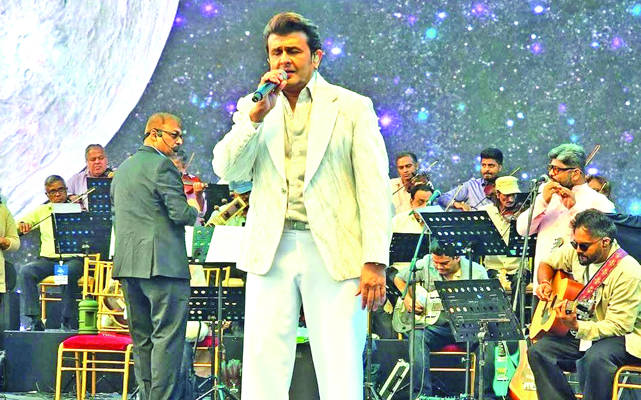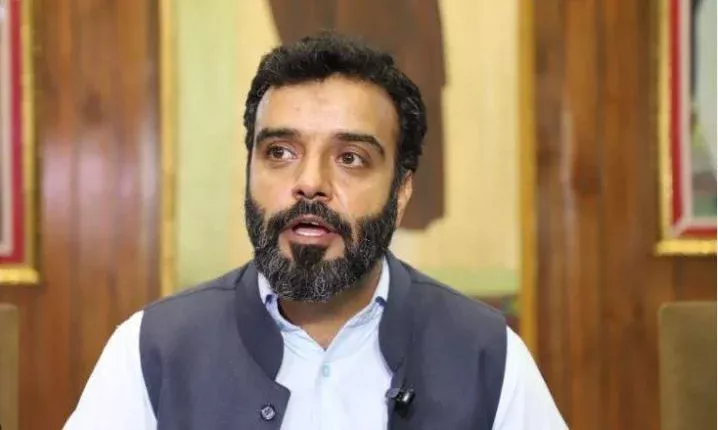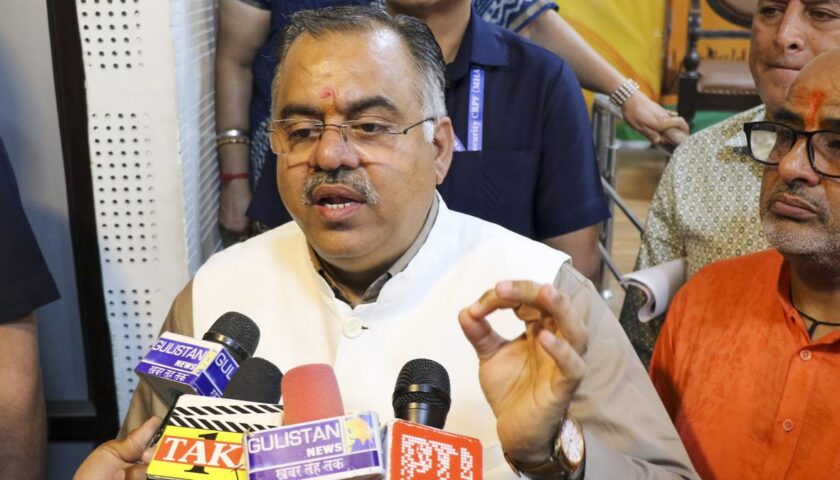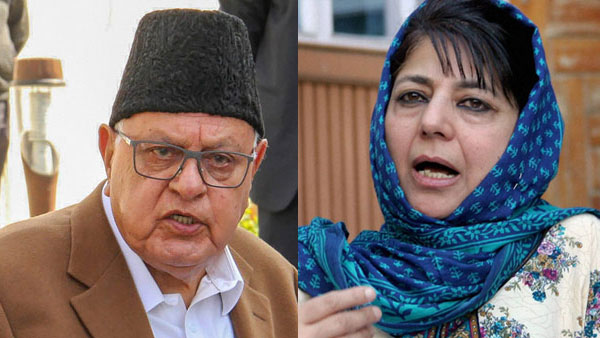Low Turnout at Sonu Nigam’s Srinagar Concert as Past ‘Azaan’ Remarks Resurface
By: Javid Amin | 26 October 2025
A Musical Evening That Turned Into a Reflection of Memory and Sentiment
What was envisioned as a landmark cultural evening by the banks of Dal Lake turned into a quiet reflection on the complexities of faith, art, and public memory. Bollywood singer Sonu Nigam, once among India’s most celebrated voices, performed at the Sher-i-Kashmir International Conference Centre (SKICC) — but the sight that met the organizers was sobering. Rows of empty chairs, subdued applause, and an audience far smaller than expected told their own story.
Despite weeks of promotion, partnership with the Department of Tourism, and promises of a “musical milestone” for the Valley, the turnout remained disappointingly low. And the reason was as political as it was emotional: the resurfacing of Sonu Nigam’s 2017 “Azaan” remarks — a controversy that refuses to fade from public consciousness.
The Concert: A Blend of Melody, Symbolism, and Silence
Organized as part of a broader initiative to showcase Kashmir’s “peaceful cultural revival,” the concert featured performances by both national and local artists, including Qazi Touqeer, Rouhan Malik, and a tribute medley to Mohammed Rafi, a legend who continues to unite generations through song.
Nigam, dressed in understated Kashmiri attire, appeared determined to create a bridge of harmony. He paused mid-performance to acknowledge the Azaan echoing across Dal Lake — a gesture many appreciated as a mark of respect.
But outside the venue, the sentiment was more conflicted. Posters calling for a boycott of the concert had circulated on social media in the preceding week. Several Kashmiri influencers, community voices, and religious organizations urged restraint or silence, arguing that cultural engagement should not come at the cost of collective sentiment.
The Shadow of 2017: The ‘Azaan’ Remarks That Refuse to Fade
To understand the low turnout, one must revisit April 2017, when Sonu Nigam tweeted about being woken by the morning Azaan broadcast through loudspeakers, calling it a form of “forced religiousness.” The remark triggered massive outrage, particularly among Muslim communities across India.
Though Nigam later clarified that his comments were not aimed at any religion and that his criticism was directed toward noise pollution, not faith — the damage was done.
In Kashmir, where religion is deeply intertwined with identity, the episode left a lingering mark. Even after Nigam’s repeated statements of respect — including moments when he publicly paused performances during Azaan — the symbolic wound persisted.
As one local youth told a Srinagar daily, “You can apologize for words, but people remember what they felt when they first heard them.”
Social Media and the Call for Boycott
Days before the concert, #BoycottSonuNigam trended locally on social platforms, with netizens sharing screenshots of his 2017 tweets and calling out organizers for “ignoring public sentiment.”
Memes, protest videos, and digital posters flooded feeds across Kashmir, transforming what should have been a musical headline into a debate on cultural accountability.
A Facebook page titled “Artists with Responsibility” criticized the event, writing:
“Kashmir welcomes every artist, but not every attitude. Respect for our faith is non-negotiable.”
This digital mobilization mirrored similar online movements across India that have redefined celebrity accountability in the social media era.
Inside the Venue: Dissonance Between Art and Audience
Journalists covering the concert described a paradoxical atmosphere — serene yet strained. Despite the natural beauty of Dal Lake and the golden reflection of lights on water, the emotional temperature of the audience remained lukewarm.
Local attendees acknowledged Nigam’s vocal mastery but admitted feeling disconnected.
“He sang beautifully. But something in the air felt distant,” said Insha Qadri, a college student from Srinagar.
Others appreciated his humility and gesture of pausing for Azaan during the show, interpreting it as an act of reconciliation. Yet the undercurrent of skepticism persisted.
Organizers, who had expected a crowd of over 3,000, reportedly counted fewer than 800 attendees. Ticket counters and online sales confirmed a late drop in bookings once the boycott narrative gained traction.
Government and Tourism Angle: Cultural Diplomacy Misfired?
The Jammu & Kashmir Tourism Department had backed the event as part of its “Cultural Harmony Series,” aimed at positioning the Valley as a hub of inclusive art and tourism.
For the administration, bringing mainstream Indian artists to perform in Srinagar was intended to signal normalcy and openness — a message of “oneness through music.”
However, the tepid response and social backlash exposed how cultural diplomacy can backfire if public sentiment is not gauged beforehand.
A senior tourism official (speaking anonymously) told Kashmir Post:
“We wanted to celebrate art as a bridge. But bridges need both sides willing to cross.”
Cultural Memory and Religious Sensitivity: Why Kashmir Is Different
Unlike many parts of India where the 2017 controversy faded, in Kashmir, faith and public identity remain deeply intertwined. The Azaan, beyond being a religious call, represents a rhythm of daily life — an anchor amid uncertainty.
Therefore, an artist’s perceived insensitivity toward that rhythm can resonate as a cultural slight, not just a statement.
Kashmiri sociologist Dr. Mubeena Rasool explains:
“For Kashmiris, Azaan is not just a sound. It’s a moment of community, a shared pause. When someone questions its presence, they question that shared pause.”
This emotional layer explains why even gestures of apology or respect by Nigam, though appreciated, could not entirely erase the memory of his earlier comments.
Sonu Nigam’s Position: Apology, Clarification, and Persistence
To his credit, Sonu Nigam has often tried to clarify his stance. In multiple interviews, he has said:
“I respect all faiths. My issue was with decibel levels, not devotion.”
In 2025, before his Srinagar performance, he told the media:
“I’m here to sing for everyone — for Kashmir, for peace, for unity. If I’ve hurt anyone in the past, I hope tonight’s music heals that.”
During the concert, when the Azaan began, Nigam stopped singing mid-song, stood silently, and folded his hands — a moment that drew quiet applause.
Yet for some, that gesture came too late to reverse the collective hesitation the controversy had already reawakened.
The Politics of Culture: Between Forgiveness and Identity
The low turnout also opens a larger debate — can artists ever truly separate art from ideology, or does every performance carry a political echo?
In Kashmir, where cultural expression is often tied to resistance, memory, and identity, forgiveness has social prerequisites. It is earned, not assumed.
Art critics argue that Nigam’s visit, while sincere, failed to engage meaningfully with local artists and communities beforehand. A pre-concert dialogue or outreach could have softened public perception.
Instead, the event appeared to many as a top-down cultural initiative — designed more for optics than for connection.
Local Artists React: Respect, Regret, and Reflection
Kashmiri singers like Rouhan Malik and Qazi Touqeer defended the event as “a chance to bring music back to Kashmir’s mainstream calendar.”
Rouhan said in a radio interview:
“We shouldn’t cancel culture. We should channel it. If Sonu Nigam sings in Kashmir, that should open space for Kashmiri artists to perform in Mumbai too.”
Others, however, felt that the controversy overshadowed the local talent that shared the stage. One event manager remarked that “national stars still dominate the spotlight, even when their controversies dim the light.”
Voices from the Valley: Divided Yet Thoughtful
Public opinion in the Valley remains split. While conservative groups continue to view Nigam’s presence as unwelcome, younger Kashmiris show more openness.
A survey conducted by Kashmir Pulse among 200 respondents showed:
- 43% felt the boycott was justified,
- 37% said artists should be given a second chance,
- 20% were undecided but admitted “social pressure” influenced their stance.
This generational divide suggests that cultural reconciliation in Kashmir will depend on dialogue, not denial.
What This Means for Future Cultural Events
The Sonu Nigam concert has become a case study for organizers and policymakers. It underscores how cultural memory can outweigh marketing, and how artists must navigate a web of faith, history, and identity when performing in sensitive regions.
Going forward, experts recommend:
- Local partnership and dialogue before events.
- Contextual sensitivity training for artists and organizers.
- Balanced representation of Kashmiri artists.
- Avoidance of political overtones in cultural outreach.
Editorial Reflection: Art Cannot Bypass Emotion
The empty chairs at SKICC are not just about attendance — they are about emotional presence. They symbolize how words, once spoken, can linger longer than songs, and how in a place like Kashmir, memory is as real as melody.
Sonu Nigam’s concert will not be remembered for its notes, but for its nuance — a reminder that reconciliation in art, like in politics, must begin with listening.




